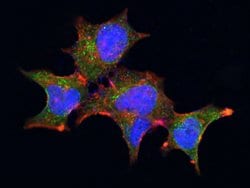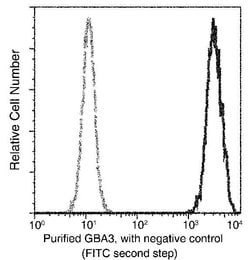Learn More
Invitrogen™ GBA3 Recombinant Rabbit Monoclonal Antibody (008)
Rabbit Recombinant Monoclonal Antibody
Supplier: Invitrogen™ MA529284
Description
This product is preservative free. It is recommended to add sodium azide to avoid contamination (final concentration 0.05%-0.1%). Recombinant rabbit monoclonal antibodies are produced using in vitro expression systems. The expression systems are developed by cloning in the specific antibody DNA sequences from immunoreactive rabbits. Then, individual clones are screened to select the best candidates for production. The advantages of using recombinant rabbit monoclonal antibodies include: better specificity and sensitivity, lot-to-lot consistency, animal origin-free formulations, and broader immunoreactivity to diverse targets due to larger rabbit immune repertoire. This antibody has specificity for Human GBA3.
GBA3, or cytosolic beta-glucosidase (EC 3.2.1.21), is a predominantly liver enzyme that efficiently hydrolyzes beta-D-glucoside and beta-D-galactoside, but not any known physiologic beta-glycoside, suggesting that it may be involved in detoxification of plant glycosides. GBA3 also has significant neutral glycosylceramidase activity (EC 3.2.1.62), suggesting that it may be involved in a nonlysosomal catabolic pathway of glucosylceramide metabolism.
Specifications
| GBA3 | |
| Recombinant Monoclonal | |
| 1 mg/mL | |
| PBS with no preservative | |
| Q9H227 | |
| GBA3 | |
| Recombinant Human GBA3 protein (Met1-Leu469). | |
| 100 μL | |
| Primary | |
| Human | |
| Antibody | |
| IgG |
| Flow Cytometry, Immunocytochemistry | |
| 008 | |
| Unconjugated | |
| GBA3 | |
| CBG; CBGL1; Cytosolic beta-glucosidase; cytosolic beta-glucosidase-like protein 1; Cytosolic GCase; Cytosolic glycosylceramidase; Gba3; GLUC; Glucosidase beta acid 3; glucosidase, beta, acid 3; glucosidase, beta, acid 3 (cytosolic); Glucosylceramidase beta 3; glucosylceramidase beta 3 (gene/pseudogene); klotho-related protein; KLRP | |
| Rabbit | |
| Protein A | |
| RUO | |
| 57733 | |
| Store at 4°C short term. For long term storage, store at -20°C, avoiding freeze/thaw cycles. | |
| Liquid |
Your input is important to us. Please complete this form to provide feedback related to the content on this product.

